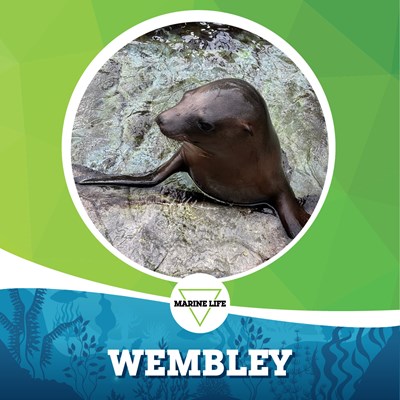
California Sea Lions
Scientific Name Zalophus californianus
Native To Pacific coast of North America and the Galapagos Islands
Habitat Rocky shores
Diet Over 50 species of fish including: salmon, octopuses, northern anchovy, herring, opaleye and squid. At West Edmonton Mall, we feed our sea lions squid, herring, capelin, smelt and mackerel.
Size and Age Males up to 2.4 m (8 ft) long, 340 kg (750 lbs), females generally no larger than 100 kg (220 lbs); average lifespan of 20-30 years
Natural History
California sea lions are “eared seals” which are commonly mistaken as "true seals." Sea lions (or eared seals) and true seals can be differentiated by the way they move on land and by their ears. Sea lions have a rotating hip bone, which allows them to tuck in their hind flippers so they can walk, run, jump and climb. True seals, on the other hand, have a fused hip bone and are not capable of walking, running or even jumping; they slide more on their bellies. Sea lions have external ear flaps that are easy to see, whereas true seals simply have tiny holes covered by fur.
Near Threatened

Conservation Status
Like all marine mammals, California sea lions are protected under the Marine Mammal Protection Act (MMPA). Common threats for these animals are: incidental catch and entanglement in fishing gear, gunshot wounds, or other human-caused injuries—commercial fisherman view them as a nuisance.
A few words from our Sea Lion Trainers:
"Having the chance to be a part of our sea lion's lives all the way into their old age is a very unique opportunity based off trust and mutual respect between the keeper and the animal. Building a relationship where the animal allows us to touch them, give them voluntary eyedrops, brush their teeth, administer medication and conduct medical procedures is very rewarding in itself. Having an animal that may no longer see us clearly or hear us clearly but still trusts us to care for them is extremely fulfilling and a big responsibility. Caring for geriatric animals requires a lot of patience and compassion, trying our best to understand how to meet their needs and give them the best life possible under our care."
-Rachelle
Interesting Facts
- Sea lions have a total of 40-60 vibrissae (whiskers) that are supplied with muscles and nerves. They are used to find fish when the water is dark and visibility is low.
- They can swim as fast as 40 km (25 mi) an hour.
- They have the ability to dive as far as 274 m (899 ft), but generally they won’t dive that deep because their food is found in shallower waters.
- Sea lions have a blubber layer that insulates and keeps them warm. Excess blubber can also function as an energy reserve. This is particularly important for males, due to their fasting during breeding season
Our Sea Lions

Quinty
Quinty, our female California sea lion, was born at the Royal Artis Zoo in Amsterdam on June 13, 2007. She joined us at Marine Life on December 20, 2007, when she as only a year and a half.
Quinty gave birth to her son, Wembley, in 2022, and has proved herself to be an excellent mother. She is a curious, smart, vocal sea lion, and is very motivated by learning new things. She is also very strong and graceful, and watching her soar through the air when she leaps out of the water is always a joy for anyone to see.

Pablo
Pablo was born in Blackpool, England on June 14, 1996. He joined us here at Marine Life on October 23, 2004. As our oldest male sea lion, he is by far our largest – weighing up to 260kg depending on the season!
He currently lives at Sea Lion’s Rock alongside Quinty, and his son Wembley. His favourite thing to do is nap on the bottom of the pool – if you walk past Sea Lions’ Rock and see a dark shape resting on the bottom of the pool you’re most likely seeing Pablo!
Pablo is considered to be quite old for a California sea lion. Being a geriatric animal means that our trainers and veterinary care team have adjusted his care and daily schedule to provide him the best care possible in his golden years. This includes things such as installing ramps for easier exits from the pools, and training auditory cues for when his vision is not as sharp as it used to be.

Wembley
Wembley was born on July 20, 2002, to mom Quinty and dad Pablo, right here at West Edmonton Mall. He is very energetic and loves to play and learn new things. One of his favourite enrichment items is a water gun! He often chases and bites at the stream of water when it is used. He also has been known to lounge on a large floating yellow mat that was weaved by trainers using firehose provided by Stony Plain Firehall.
If you would like to catch a glimpse of Wembley, keep an eye on our large show pool. He often spends time during the day hanging out in the pool, sometimes alone and sometimes with his parents. He’s also starting to make appearances during our sea lion presentations as well!

